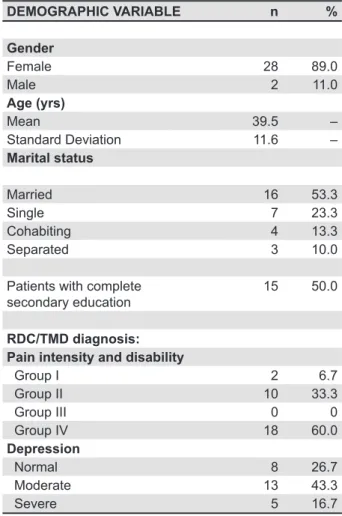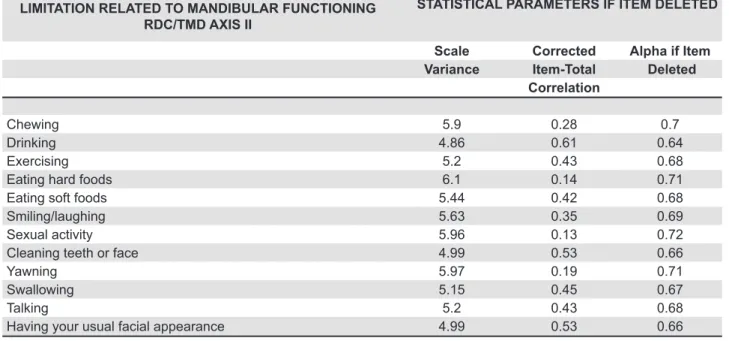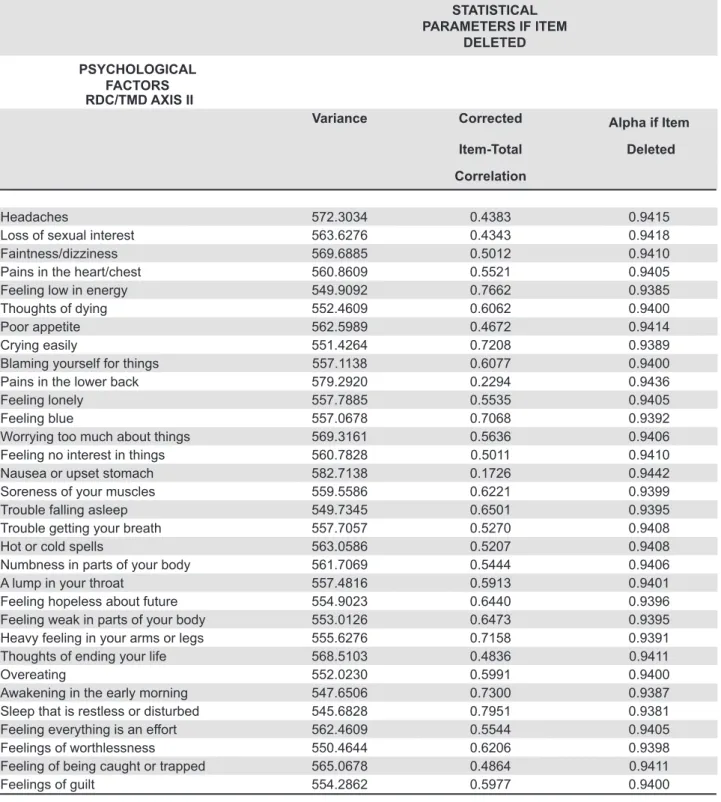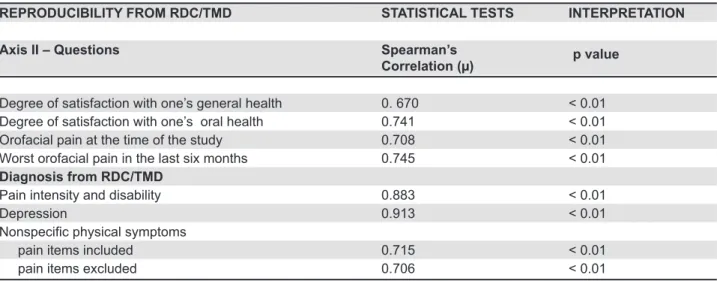Validation of the multimedia version of the RDC/
TMD axis II questionnaire in Portuguese
Ricardo Figueiredo CAVALCANTI1, Luciana Moraes STUDART2, Maurício KOSMINSKY3, Paulo Sávio Angeiras de GOES4
1- DDS, Dental School, University of Pernambuco, Camaragibe, PE, Brazil.
2- DDS, Graduate student in Science of the Language, Catholic University of Pernambuco, Camaragibe, PE, Brazil.
3- PhD, Senior Lecturer, Discipline of Restorative Dentistry, Dental School, University of Pernambuco, Camaragibe, PE, Brazil. 4- PhD, Senior Lecturer, Discipline of Public Health, Dental School, University of Pernambuco, Camaragibe, PE, Brazil.
Corresponding address: Prof. Dr. Paulo Sávio Angeiras de Góes - Faculdade de Odontologia de Pernambuco - Departamento de Odontologia Social - Av. Gen. Newton Cavalcanti, 1650 - Tabatinga - Camaragibe - PE - e-mail: psagoes@uol.com.br
!"!#$!%&'(")*+!,'-./'0112'3'4*%#5"6)#*7&'8!+,96,:'-;/'01-1'3'<""!=)!%&'46,">'-?/'01-1
ABSTRACT
O
bjective: The aim of the study was to validate the multimedia version of the ResearchDiagnostic Criteria for Temporomandibular Disorders (RDC/TMD) Axis II Questionnaire in Portuguese language. Material and methods: The sample comprised 30 patients with signs and symptoms of temporomandibular disorders (TMD), evaluated at the Orofacial Pain Control Center of the Dental School of the University of Pernambuco, Brazil, between April !"#$%!&#'(()*#+ , #-.//&-,0.!#1 2#3&45.46&"#%20!7#,8.//.10!7#0!2,4%6&!,29#:063/0;&"# Anamnestic Index (SAI) and RDC/TMD Axis II written version and multimedia version. The validation process consisted of analyzing the internal consistency of the scales. Concurrent and convergent validity were evaluated by the Spearman’s rank correlation. In addition, test and analysis of reproducibility by the Kappa weighted statistical test and Spearman´s rank correlation test were performed. Results: The multimedia version of the RDC/TMD <=02#>>#?%&2,0.!! 04�!#@.4,%7%&2 2#-.!20"&4&"#-.!202,&!,#AB4.6C4 -8# /38 #D#(*EFGH# reproducible (Spearman 0.670 to 0.913, p<0.01) and valid (p<0.01). Conclusion: The questionnaire showed valid and reproducible results, and represents an instrument of practical application in epidemiological studies of TMD in the Brazilian population
Key words: Computer-assisted, diagnosis. Temporomandibular joint dysfunction syndrome.
Validation studies.
INTRODUCTION
Temporomandibular disorders (TMD) is a collective term embracing a number of clinical problems that involve the masticatory musculature, the temporomandibular joint or both11. Most
diagnosed patients suffer from muscle and/or joint pain on palpation and/or mandibular movements13.
Epidemiological studies on TMD have shown conflicting results regarding prevalence and
0!-0"&!-&*# :%-8# ;!"0!72# -.%/"# C&# ,,40C%,&"# ,.#
different diagnostic criteria. Thus, a standardized methodology is necessary when comparing studies related to these diseases6,10.
I8&#-.!,4 "0-,.4J#;!"0!72#6 J#C&# ,,40C%,&"#0!#
part to the lack of standardized diagnostic criteria
for defining clinical subtypes of TMD and for psychological assessment. In order to overcome this
"05;-%/,JH#+1.4K0!# !"#L&M&2-8&2 (1992) developed
a set of diagnostic tools for TMD, namely the Research Diagnostic Criteria for Temporomandibular Disorders (RDC/TMD), including clinical aspects (Axis I) and psychological/psychosocial factors (Axis II). Axis I permits the reproducibility of the diagnostic criteria for research on TMD in their most common forms of muscle and joint involvement, while Axis II enables the physical diagnosis to be coordinated with an operational assessment of the psychological distress and psychological dysfunction associated with TMD2,3,12,17.
The production of the RDC/TMD represented an advance in the study of this subject2,16. Although
the most common forms of TMD14,16, it provides
specifications for conducting a standardized clinical physical examination. It has been formally translated/back-translated into 20 languages and is the most common diagnostic method used by the 45-member consortium of RDC/TMD-based international researchers (International Consortium for RDC/TMD-based Research, 2004). Recent studies have demonstrated the validity and reliability of the clinical diagnosis of TMD8,13. Furthermore, several
studies of the validation of diagnosis in TMD have focused on RDC, comparing its consistency with that of other imaging techniques13.
Due to the importance of psychosocial factors in the diagnosis of TMD, the time lag between the examination of the patient and the collection of data has proved to be a problem. With a view to solving this problem, Yap, et al.18 (2001) developed
an on-line computerized version of the RDC/ TMD questionnaire that, despite facilitating the diagnosis, encountered a number of operational problems involving the patient’s difficulties in answering the questions and using the computer.
<5,&4# ,8&# 0!0,0 /# 34.-&22H# # ;! /# 34.-&"%4&# .5#
validation was carried out, as a result the RDC/ TMD PORTUGUESE VERSION became available to be used in studies conducted in Brazilian population.
The aim of this prospective study was to validate the Brazilian Portuguese-language multimedia version of the RDC/TMD Axis II Questionnaire, a standardized form of research on TMD, enhancing the interaction of clinicians and researchers.
MATERIAL AND METHODS
The present multimedia version of the Questionnaire Axis II of the RDC/TMD followed the written version of the questionnaire in Portuguese validated by Lucena, et al.9 (2006).
It runs on Windows OS 2000 and XP and can exploit multimedia software and data storage bank capabilities.
The questionnaire was designed in such a way that the patient could hear the video presentation and visualize the question, so that at the end of each presentation, the respondent could answer the question, replay it, or go back. The types of questions included yes/no questions and multiple-choice questions. The Graduated Chronic Pain Scale (GCPS) was used for the questions measuring the intensity of pain.
The study population consisted of patients with orofacial pain seeking treatment at the Orofacial Pain Control Center of the Dental School of the University of Pernambuco, Brazil, between April and June 2006. The ages of the subjects ranged
54.6#NE#,.#OO#J& 42#A6& !#D#PE*O#J& 42GH#EP*PQ#
of whom were females and 6.7% males. All patients
had TMD. The inclusion criteria were no previous history of TMD treatment and a positive diagnosis of
IR+H#%20!7#,8&#:063/0;&"#<! 6!&2,0-#>!"&=#A:<>G5.
The sociodemographic data of all the subjects with TMD are presented in Table 1.
The research project involving research on humans was submitted to the Research Ethics Committee of the University of Pernambuco after granting the permission from the Dental School. Only patients who agreed to participate and signed the informed consent form were enrolled in the study.
The following questionnaires were answered by the participants: 1) SAI5 questionnaire, which
S&40;&"# ,8&# 34&2&!-&# .5# 207!2# !"# 2J63,.62# .5#
TMD, enabling a prompt diagnosis. All patients
1&4&# -/ 220;&"# 2# 8 S0!7# IR+*# 'G# @.4,%7%&2&T
language written version of the RDC/TMD Axis II Questionnaire10, which consisted of 31 items,
divided into sociodemographic, socioeconomic, psychological and psychosocial factors, signs and symptoms, and scale of limitation of mandibular function. 3) Portuguese-language multimedia version of the RDC/TMD Axis II Questionnaire.
The questionnaires were applied to the 30 participants one day after the initial interview as
DEMOGRAPHIC VARIABLE n %
Gender
Female 28 89.0
Male 2 11.0
Age (yrs)
Mean 39.5 –
Standard Deviation 11.6 –
Marital status
Married 16 53.3
Single 7 23.3
Cohabiting 4 13.3
Separated 3 10.0
Patients with complete secondary education
15 50.0
RDC/TMD diagnosis: Pain intensity and disability
Group I 2 6.7
Group II 10 33.3
Group III 0 0
Group IV 18 60.0
Depression
Normal 8 26.7
Moderate 13 43.3
Severe 5 16.7
follows: 15 were given the written questionnaire and 15 the multimedia questionnaire for the purpose of testing the validity by means of process test/retest the instrument. None of the patients had received any previous treatment for any associated comorbidity, any pharmacological or psychological therapy for TMD. All of them answered the SAI questionnaire.
The validation process consisted of verifying the internal consistency of the scales of limitation of mandibular function and psychological factors. In order, to have an acceptable internal consistency, a scale should present alpha values of at least 0.7. Convergent validity was simultaneously evaluated by Spearman’s rank correlation test10. The
reproducibility analysis used the weighted Kappa statistical test and Spearman’s rank correlation test (µ>0.05)13. The Statistical Package for the Social Sciences (SPSS) for Windows, Version 10, was used for descriptive and inferential analysis of the data.
I8&#/&S&/#.5#2, ,02,0- /#207!0;- !- 2#2&,# ,#OQ*#
Internal consistency was estimated by Cronbach’s alpha test, values above 0.5 being considered satisfactory14.
RESULTS
The time taken by the patients who answered the multimedia questionnaire ranged from 15 to 40 min (mean time of 25 min). By comparing the information obtained from 30 patients submitted to evaluations by two exams with the two versions of the RDC/TMD questionnaire at different times (study test-retest), a consistent and reproducible
0!2,4%6&!,#1 2#0"&!,0;&"#5.4#.C, 0!0!7# #"0 7!.202*
The analysis of the internal consistency of the limitation of mandibular function as a RDC/TMD
<=02#>>#"0 7!.2,0-#-40,&40.!#0"&!,0;&"#N'#0,&62#,8 ,#
correlated with each other and with the overall result of the scale, comprising a true scale, with
/38 D(*UN# !"##2, !" 4"0V&"# /38 D(*U(#AI C/&#
2).
In addition to the internal consistency of the questions related to psychological factors, comprising 32 items, which also correlated with one another, since the alpha values exceeded 0.90
A /38 D(*EF# !"#2, !" 4"0V&"# /38 D(*EFG#AI C/&#
3). Therefore, the alpha values for scale were not increased by the exclusion of any of the items tested.
The multimedia RDC/TMD Questionnaire proved to be reproducible, presenting correlations greater than µ>0.05, all of which showed statistical 207!0;- !-&# 18&!# &S /% ,&"# ,# "055&4&!,# ,06&2#
(Spearman 0.670 to 0.745, p<0.01) (Table 4). The reproducibility of the different domains of RDC/TMD Axis II, considering the severity of chronic pain and the three subscales of psychological factors
A"&34&220.!H# !.!23&-0;-# 38J20- /# 2J63,.62# 10,8#
and without pain items), was analyzed. Considering the information obtained from the 30 patients
(test-4&,&2,# 2,%"JGH# ,8&4&# 1 2# # 2, ,02,0- //J# 207!0;- !,#
diagnostic agreement in Axis II (µ W(*UX#3Y(*(NG# (Table 4).
LIMITATION RELATED TO MANDIBULAR FUNCTIONING RDC/TMD AXIS II
STATISTICAL PARAMETERS IF ITEM DELETED
Scale Corrected Alpha if Item Variance Item-Total Deleted
Correlation
Chewing 5.9 0.28 0.7
Drinking 4.86 0.61 0.64
Exercising 5.2 0.43 0.68
Eating hard foods 6.1 0.14 0.71
Eating soft foods 5.44 0.42 0.68
Smiling/laughing 5.63 0.35 0.69
Sexual activity 5.96 0.13 0.72
Cleaning teeth or face 4.99 0.53 0.66
Yawning 5.97 0.19 0.71
Swallowing 5.15 0.45 0.67
Talking 5.2 0.43 0.68
Having your usual facial appearance 4.99 0.53 0.66
Table 2- Internal consistency of limitations related to mandibular functioning values of RDC/TMD Axis II, evaluated by test-retest in 30 patients
DISCUSSION
Patients younger than 18 years were excluded
54.6#,8,%"J#C&- %2 !J#?%&2,0.!2# 4&#"05;-%/,#
for them to understand or inappropriate and because the RDC/TMD has been calibrated with data only on patients over the age of 18 years18.
The size of the study sample was based on
validation and cultural adaptation studies, using groups with 10 to 37 patients1,9,15.
The Portuguese-language written version of the RDC/TMD Axis II Questionnaire was validated by Lucena, et al.9 (2006) using criteria established
in similar studies1,3,7, generating a reliable and
reproducible instrument, as estimated by the Kappa statistical test and consistent on Cronbach’s alpha
STATISTICAL PARAMETERS IF ITEM
DELETED
PSYCHOLOGICAL FACTORS RDC/TMD AXIS II
Variance Corrected Alpha if Item
Item-Total Deleted
Correlation
Headaches 572.3034 0.4383 0.9415 Loss of sexual interest 563.6276 0.4343 0.9418 Faintness/dizziness 569.6885 0.5012 0.9410 Pains in the heart/chest 560.8609 0.5521 0.9405 Feeling low in energy 549.9092 0.7662 0.9385
Thoughts of dying 552.4609 0.6062 0.9400
Poor appetite 562.5989 0.4672 0.9414 Crying easily 551.4264 0.7208 0.9389 Blaming yourself for things 557.1138 0.6077 0.9400 Pains in the lower back 579.2920 0.2294 0.9436 Feeling lonely 557.7885 0.5535 0.9405 Feeling blue 557.0678 0.7068 0.9392 Worrying too much about things 569.3161 0.5636 0.9406 Feeling no interest in things 560.7828 0.5011 0.9410 Nausea or upset stomach 582.7138 0.1726 0.9442 Soreness of your muscles 559.5586 0.6221 0.9399 Trouble falling asleep 549.7345 0.6501 0.9395 Trouble getting your breath 557.7057 0.5270 0.9408 Hot or cold spells 563.0586 0.5207 0.9408 Numbness in parts of your body 561.7069 0.5444 0.9406 A lump in your throat 557.4816 0.5913 0.9401 Feeling hopeless about future 554.9023 0.6440 0.9396 Feeling weak in parts of your body 553.0126 0.6473 0.9395 Heavy feeling in your arms or legs 555.6276 0.7158 0.9391 Thoughts of ending your life 568.5103 0.4836 0.9411
Overeating 552.0230 0.5991 0.9400
Awakening in the early morning 547.6506 0.7300 0.9387 Sleep that is restless or disturbed 545.6828 0.7951 0.9381 Feeling everything is an effort 562.4609 0.5544 0.9405 Feelings of worthlessness 550.4644 0.6206 0.9398 Feeling of being caught or trapped 565.0678 0.4864 0.9411
Feelings of guilt 554.2862 0.5977 0.9400
Table 3- Internal consistency of the scale of psychological factors values of RDC/TMD Axis II, evaluated by test-retest in 30 patients
REPRODUCIBILITY FROM RDC/TMD STATISTICAL TESTS INTERPRETATION
Axis II – Questions Spearman’s
Correlation (µ) p value
Degree of satisfaction with one’s general health 0. 670 < 0.01 Degree of satisfaction with one’s oral health 0.741 < 0.01 Orofacial pain at the time of the study 0.708 < 0.01 Worst orofacial pain in the last six months 0.745 < 0.01 Diagnosis from RDC/TMD
Pain intensity and disability 0.883 < 0.01
Depression 0.913 < 0.01
!"#$%&'(&)$*+#'&,-)#+.$/!.#
pain items included 0.715 < 0.01
pain items excluded 0.706 < 0.01
Table 4- Reproducibility of the questions and of established diagnostic procedures in RDC/TMD Axis II, evaluated by test-retest of 30 patients
reliability test.
The mean age of the patients in this study was 39.5 years, which corresponds to that found in most studies on TMD3,4,8-10,16-19. With regard to gender, in
the studied population, 28 (93.3%) were females and 2 (6.7%) males. Despite the fact that several studies report a predominance of females with TMD, this predominance in our group was above average3,4,8-10,16-19.
In this study the assessment of the internal consistency of the scales of limitation of mandibular function and psychological factors presented an overall alpha index of 0.71 and 0.94, respectively. The lowest value used as baseline in clinical studies is 0.713. Thus, the internal consistency
of the scales was valid, resulting in a true scale. Spearman’s ranks test demonstrated that the proposed version of the instrument generally had a positive correlation, indicating that the validated version is indeed measuring what it was intended to measure14.
This study represents an important step for research on TMD in Brazil in several aspects. Firstly, it represents an advance in relation to the method of research previously reported15 in the study of the
TMD; in addition, it will facilitate future population studies involving TMD. As a result, the multimedia version will reduce the cost of printing, making copies of the questionnaire and storing patient data.
The present multimedia questionnaire also permits greater speed in the collection of patient data, storage and statistical analysis, with information being simultaneously entered in a database while the research is being conducted. It also has the advantage of eliminating any bias on the part of the interviewer when dealing with sensitive questions. However, results must be interpreted considering its limitations, as it has been carried out in a specialized pain clinic and with
a limited sample of patients. Future investigation
0!# #C4. "#&30"&60./.70- /#2%4S&J#28.%/"#-.!;46#
the results.
CONCLUSION
The process of validating the Portuguese multimedia version of the RDC/TMD Axis II Questionnaire followed the methodology proposed in the literature and resulted in a reproducible and readily applicable instrument, valid for the Brazilian population, making it possible to introduce an innovative standardized method in epidemiological studies on TMD in Brazil.
AKNOWLEDGEMENTS
This project was supported by PIBIC/CNPq.
REFERENCES
1- Ciconelli RM, Feraz MB, Santos W, Meinão I, Quaresma MR. Tradução para a língua portuguesa e validação do questionário genérico de avaliação de qualidade de vida SF-36 (Brasil SF-36). Rev Bras Reumatol. 1999;39(3):143-50.
2- Dworkin SF, LeResche L. Research diagnostic criteria for temporomandibular disorders: review, criteria, examinations and
23&-0;- ,0.!2H#-40,0?%&*#$#B4 !0.6 !"#+02.4"*#NEE'X)AFG9P(NTOO*
3- Dworkin SF, Sherman J, Mancl L, Ohrbach R, LeResche L, Truelove E. Reliability, validity and clinical utility of the research diagnostic criteria for Temporomandibular Disorders Axis II Scales:
"&34&220.!H#!.!T23&-0;-#38J20- /#2J63,.62H# !"#74 "&"#-84.!0-#
pain. J Orofacial Pain. 2002;16(3):207-20.
4- Emshoff R, Rudisch A. Validity of clinical diagnostic criteria for temporomandibular disorders; clinical versus magnetic resonance imaging diagnoses of temporomandibular joint internal derangement and ostheoarthrosis. Oral Surg Oral Med Oral Pathol Oral Radiol Endod. 2001;91(1):50-5.
7- John MT, Dworkin SF, Mancl LA. Reliability of clinical temporomandibular disorder diagnoses. Pain. 2005;118(1-2):61-9.
8- List T, Dworkin SF. Comparing TMD diagnoses and clinical findings at Swedish and US TMD centers using research diagnostic criteria for temporomandibular disorders. J Orofac Pain. 1996;10(3):240-53.
9- Lucena LB, Kosminsky M, Costa LJ, Góes PS. Validation of the Portuguese version of the RDC/TMD Axis II questionnaire. Braz Oral Res. 2006;20(4):312-7.
10- McNeill C. Temporomandibular disorders: guidelines for classification, assessment and management. The American Academy of Orofacial Pain. 2nd ed. Chicago: Quintessence; 1993. p.11-3.
11- Pereira LJ, Pereira-Cenci T, Pereira SM, Cury AA, Ambrosano GM, Pereira AC, et al. Psychological factors and the incidence of temporomandibular disorders in early adolescence. Braz Oral Res. 2009;23(2):155-60.
12- Schmitter M, Ohlmann B, John MT, Hirsch C, Rammelsberg P. Research diagnostic criteria for temporomandibular disorders: a calibration and reliability study. Cranio. 2005;23(3):212-8.
13- Streiner DL, Norman GR. Health measurement scales. 2nd ed. New York: Oxford Press; 1995.
14- Svenson P. Orofacial musculoskeletal pain. In: Giamberardino MA. Pain 2002: an updated review: refresher course syllabus. Seattle: IASP Press; 2002. p.447-58.
15- Tosato Jde P, Caria PH. Electromyographic activity assessment of individuals with and without temporomandibular disorder symptoms J Appl Oral Sci. 2007;15(2):152-5.
16- Yap AU, Chua EK, Dworkin SF, Tan HH, Tan KB. Multiple pains and psychosocial functioning/ psychologic distress in TMD patients. Int J Prosthodont. 2002;15(5):461-6.



